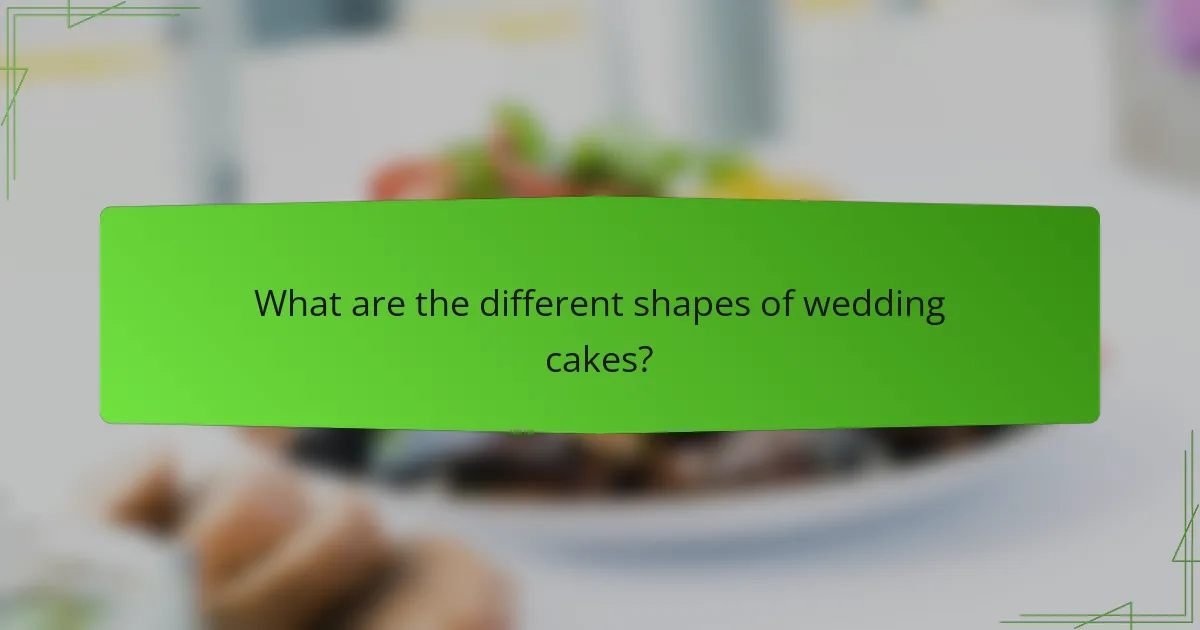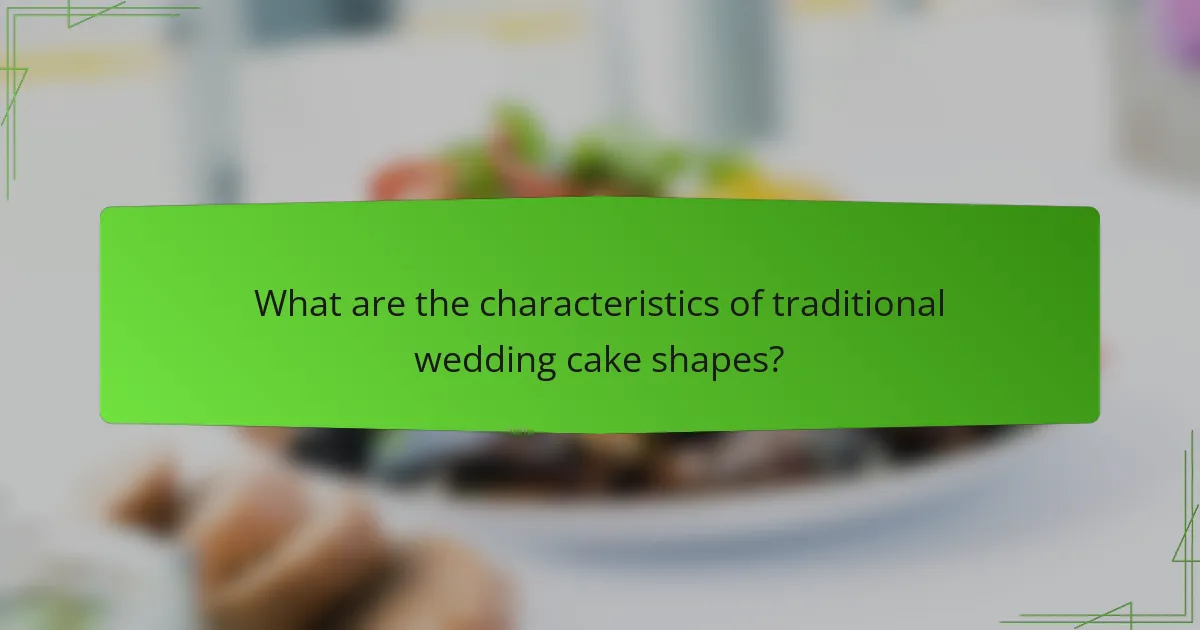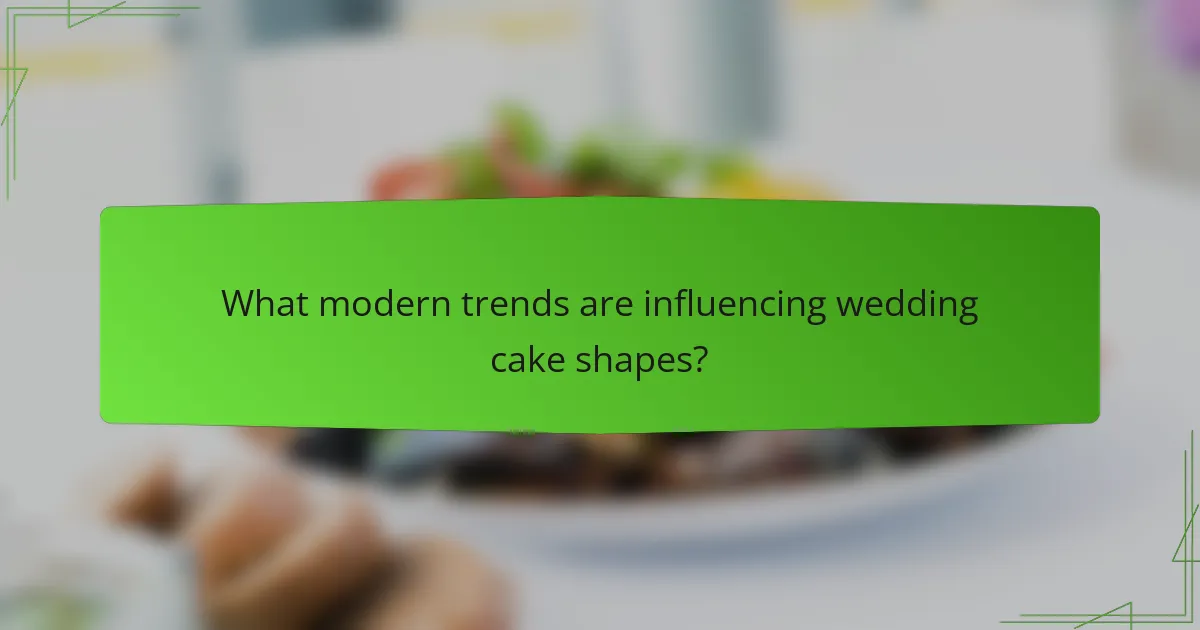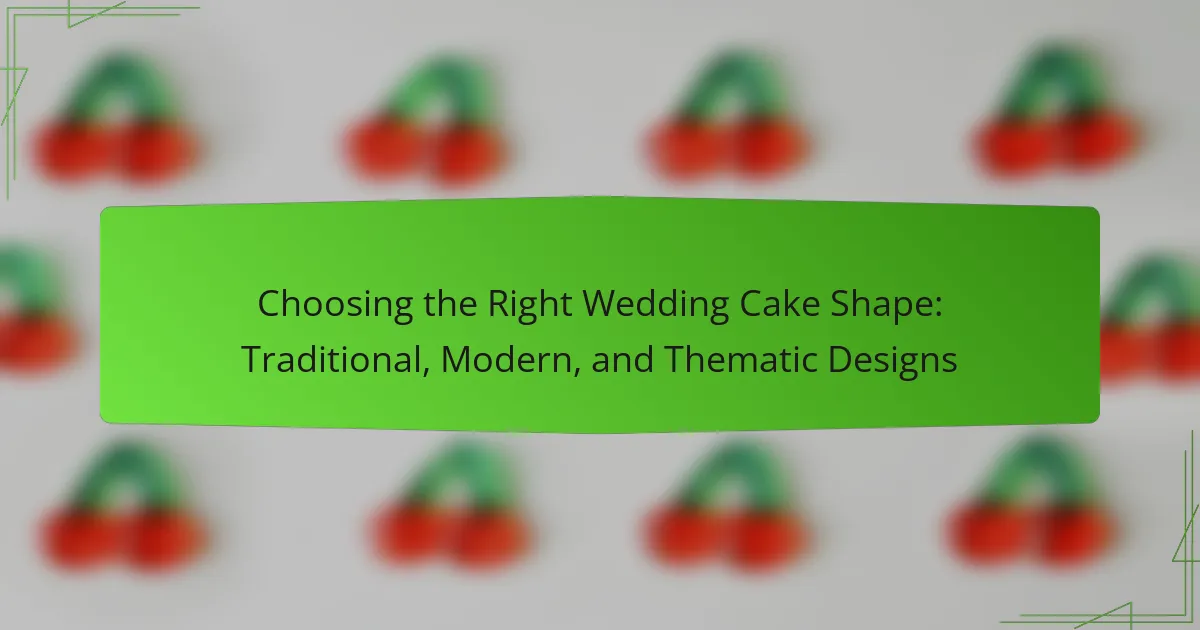
What are the different shapes of wedding cakes?
Wedding cakes come in various shapes, including round, square, rectangular, and hexagonal. Round cakes are the most traditional and popular shape for weddings. Square cakes offer a modern and sleek appearance. Rectangular cakes can be used for larger gatherings and provide more serving options. Hexagonal cakes add a unique twist to the traditional shapes. Each shape can be tiered or single-layered, allowing for customization. The choice of shape often reflects the couple’s style and wedding theme.
How do traditional wedding cake shapes differ from modern ones?
Traditional wedding cake shapes are typically round or square, emphasizing tiered designs. These shapes symbolize unity and stability. In contrast, modern wedding cakes often feature unique shapes like hexagons, asymmetrical designs, or even sculptural forms. This shift reflects contemporary aesthetics and personalization trends. Traditional cakes are often frosted with fondant or buttercream, while modern cakes may incorporate unconventional materials like edible flowers or metallic finishes. The evolution in shapes showcases changing tastes in weddings, moving from classic elegance to creative expression.
What are the most popular traditional wedding cake shapes?
The most popular traditional wedding cake shapes are round, square, and hexagonal. Round cakes are classic and symbolize eternity. Square cakes offer a modern twist while maintaining elegance. Hexagonal cakes provide a unique geometric option that stands out. These shapes have been favored for their aesthetic appeal and structural stability. Historical trends show that round cakes have been used since ancient times, while square and hexagonal designs gained popularity in the 19th century. Each shape can be tiered, allowing for various designs and sizes to accommodate different wedding styles.
What unique features define modern wedding cake shapes?
Modern wedding cake shapes are characterized by geometric designs, asymmetry, and unconventional tiers. These shapes often include hexagons, squares, and even freeform structures. Smooth, clean lines define many modern cakes, contrasting with traditional ornate styles. Additionally, cakes may feature negative space, allowing for a minimalist aesthetic. Unique textures, such as marbling or metallic finishes, enhance visual appeal. Many modern cakes also incorporate edible floral arrangements for a contemporary touch. The use of bold colors and patterns is increasingly popular, moving away from classic white. Overall, modern wedding cake shapes reflect current design trends and personal expression.
Why is the shape of a wedding cake important?
The shape of a wedding cake is important because it symbolizes the couple’s style and theme. Different shapes convey various meanings and aesthetics. For instance, a round cake represents unity and eternity, while a square cake signifies stability. The chosen shape can also reflect cultural traditions and personal preferences. Additionally, the shape affects the cake’s serving and presentation. Unique shapes can create visual interest and enhance the overall decor of the wedding. Therefore, selecting the right shape is crucial for both symbolic and practical reasons.
How does cake shape influence the overall wedding theme?
Cake shape significantly influences the overall wedding theme. It serves as a visual focal point that reflects the couple’s style. Traditional round cakes convey elegance and classic charm. Square cakes offer a modern and structured aesthetic. Unique shapes like hexagons or tiers can enhance a themed wedding, such as rustic or vintage. The shape can also dictate the cake’s decoration style, aligning with the wedding’s color palette and floral arrangements. For instance, a whimsical cake shape complements a playful theme, while a sleek design fits a minimalist approach. Overall, the cake shape acts as an expression of the couple’s vision and enhances the cohesive feel of the wedding.
What role does cake shape play in guest experience?
Cake shape significantly influences guest experience at events. The visual appeal of a cake contributes to the overall ambiance. Unique shapes can create a memorable impression. For instance, tiered cakes often evoke elegance and sophistication. Guests may feel more excited about a cake that reflects the event’s theme. A well-chosen shape can enhance the celebratory atmosphere. Studies show that aesthetics impact food enjoyment. Therefore, cake shape plays a crucial role in shaping guests’ perceptions and enjoyment during celebrations.

What are the characteristics of traditional wedding cake shapes?
Traditional wedding cake shapes are typically multi-tiered and round. These cakes often symbolize prosperity and the couple’s future together. The round shape is the most common, representing unity and eternity. Square cakes are also popular, offering a modern twist while maintaining elegance.
Each tier is usually stacked, creating a vertical presentation. This design allows for a more dramatic display at the wedding venue. Additionally, traditional cakes often feature intricate decorations, such as fondant or buttercream icing. These decorations can include floral motifs, lace patterns, or even personalized monograms.
Historically, the multi-tiered design dates back to the Victorian era. At that time, cakes were stacked to showcase wealth and status. Today, traditional shapes remain a popular choice for weddings, reflecting both history and contemporary tastes.
What are the most common traditional wedding cake shapes?
The most common traditional wedding cake shapes are round, square, and tiered. Round cakes are classic and symbolize unity. Square cakes offer a modern twist while maintaining tradition. Tiered cakes, often round or square, create height and elegance. These shapes have historical significance in wedding customs. Round cakes date back to ancient Rome, symbolizing fertility. Square cakes became popular in the 19th century, representing stability. Tiered cakes have roots in Victorian-era celebrations, showcasing craftsmanship. Each shape serves as a canvas for decoration and personalization.
How do round cakes symbolize tradition in weddings?
Round cakes symbolize tradition in weddings by representing unity and completeness. The circular shape signifies the never-ending cycle of love and life. Historically, round cakes have been used in wedding ceremonies since ancient times. They were often made to honor deities and were believed to bring prosperity and fertility. The tradition of cutting the cake together reinforces the couple’s commitment to each other. This act is a shared moment that symbolizes their new life together. Additionally, round cakes are commonly featured in many cultures, enhancing their significance in wedding celebrations.
What is the significance of square wedding cakes?
Square wedding cakes symbolize modernity and elegance. Their geometric shape offers a contemporary aesthetic. This design contrasts with traditional round cakes. Square cakes provide a unique visual appeal. They can be easily stacked for height and drama. This stacking capability allows for creative decoration options. Square wedding cakes are also versatile for various themes. The shape can represent stability and balance in a marriage.
What are the advantages of choosing a traditional cake shape?
Traditional cake shapes offer several advantages. They are widely recognized and accepted in various cultures. A round shape is often associated with unity and eternity. This shape is also easier to slice and serve at events. Traditional shapes can be more stable and easier to decorate. They provide a classic aesthetic that complements formal occasions. Many bakers are experienced in creating traditional shapes, ensuring quality and consistency. Overall, choosing a traditional cake shape can enhance the overall experience of a wedding celebration.
How do traditional shapes enhance the aesthetic of a wedding?
Traditional shapes enhance the aesthetic of a wedding by providing a timeless and elegant look. Common shapes like round and square evoke classic beauty and symmetry. These shapes are often associated with tradition and heritage, adding a sense of cultural significance to the celebration. Round cakes symbolize unity and eternity, while square cakes represent stability and balance. The use of traditional shapes allows for intricate designs and decorations, further enhancing visual appeal. Historical references show that traditional cake shapes have been used in weddings for centuries, reinforcing their enduring popularity. This connection to the past creates a nostalgic atmosphere, making the event feel more meaningful.
What are the practical benefits of traditional cake shapes?
Traditional cake shapes offer several practical benefits. They are typically designed for stability and ease of stacking. Round cakes, for example, distribute weight evenly, reducing the risk of collapsing. Square cakes provide more servings per slice, maximizing yield for large events. Traditional shapes also align with established serving sizes, simplifying portion control. Their familiar aesthetics appeal to a wide audience, enhancing visual appeal at events. Additionally, traditional shapes are often easier to decorate, allowing for intricate designs that maintain structural integrity. These advantages make traditional cake shapes a practical choice for weddings and other celebrations.

What modern trends are influencing wedding cake shapes?
Modern trends influencing wedding cake shapes include geometric designs, asymmetrical layers, and minimalist aesthetics. Geometric shapes, such as hexagons and squares, have gained popularity for their contemporary look. Asymmetrical layers create a dynamic visual appeal, moving away from traditional tiered cakes. Minimalist aesthetics emphasize clean lines and simple decorations, reflecting a modern sensibility. Additionally, the use of bold colors and unique textures, like metallic finishes, is on the rise. These trends cater to couples seeking personalized and distinctive wedding cakes.
What are some popular modern wedding cake shapes?
Popular modern wedding cake shapes include geometric, hexagonal, and asymmetrical designs. Geometric cakes feature clean lines and sharp angles. Hexagonal shapes offer a contemporary twist on traditional round cakes. Asymmetrical designs create visual interest with uneven tiers. Other popular shapes are square and tiered styles. These shapes often incorporate unique decorations, enhancing their modern appeal. The trend towards minimalism also influences modern cake shapes, favoring simplicity and elegance.
How do geometric shapes play a role in contemporary cake design?
Geometric shapes are integral to contemporary cake design. They provide structure and visual interest. Cakes featuring geometric shapes often utilize clean lines and symmetry. This modern aesthetic appeals to couples seeking unique designs. Popular shapes include hexagons, triangles, and squares. These forms can create a minimalist or bold statement. Additionally, geometric patterns can enhance the cake’s overall theme. The use of shapes can reflect personal style and wedding themes.
What trends are emerging in asymmetrical cake designs?
Emerging trends in asymmetrical cake designs include bold geometric shapes and unexpected color combinations. Bakers are increasingly experimenting with height variations and non-traditional tiers. Textured finishes, like ruffles and brush strokes, are gaining popularity. Natural elements, such as floral arrangements, are often incorporated for a unique touch. Additionally, metallic accents are being used to enhance visual appeal. Customization is key, with couples seeking personalized designs that reflect their style. Asymmetrical cakes are now a favored choice for modern weddings, showcasing creativity and individuality.
How can couples personalize modern wedding cake shapes?
Couples can personalize modern wedding cake shapes by selecting unique designs that reflect their personalities. They can choose unconventional shapes like hexagons or asymmetrical tiers. Couples may also incorporate elements from their relationship, such as favorite hobbies or destinations. Custom colors and patterns can further enhance the cake’s appearance. Edible decorations, like flowers or figurines, can be tailored to specific themes. Additionally, couples can work with cake designers to create bespoke shapes that are meaningful to them. This approach ensures that each cake is a distinctive representation of the couple’s love story.
What unique attributes can be added to modern cake shapes?
Unique attributes that can be added to modern cake shapes include geometric designs, asymmetrical layers, and edible art. Geometric designs incorporate sharp angles and clean lines, creating a contemporary aesthetic. Asymmetrical layers provide visual interest and challenge traditional symmetry in cake design. Edible art, such as hand-painted details or intricate sugar sculptures, enhances personalization and creativity. These attributes reflect current trends in cake design and cater to diverse wedding themes.
How does flavor influence the choice of modern cake shapes?
Flavor significantly influences the choice of modern cake shapes. Different flavors can dictate the texture and structural integrity of the cake. For example, a dense chocolate cake may hold up better in a tiered structure than a lighter vanilla sponge. Additionally, unique flavor combinations often inspire creative shapes that reflect the theme or personality of the event. Flavor profiles can also inform the use of color and decoration, enhancing the visual appeal of the cake shape. A citrus-flavored cake might lead to a more vibrant, playful design, while a rich red velvet could inspire elegant, classic shapes. Overall, flavor not only affects taste but also guides aesthetic and structural decisions in cake design.
What thematic wedding cake shapes are popular today?
Popular thematic wedding cake shapes today include geometric, floral, and tiered designs. Geometric cakes feature sharp angles and clean lines, appealing to modern aesthetics. Floral cakes often incorporate intricate sugar flowers, enhancing romantic themes. Tiered designs remain classic, offering multiple layers that can be customized with different flavors. Other popular shapes include heart-shaped and hexagonal cakes, which add unique flair. These trends reflect current wedding styles, emphasizing personalization and creativity in cake design.
How can couples choose a cake shape that reflects their wedding theme?
Couples can choose a cake shape that reflects their wedding theme by aligning the design with their overall aesthetic. For example, a round cake often symbolizes unity and is suitable for traditional themes. Square cakes can convey modern elegance, fitting for contemporary weddings. Additionally, themed shapes, like hearts for romantic themes or geometric designs for minimalist styles, can enhance the visual narrative. The color scheme and decoration should also match the wedding palette to ensure cohesion. According to wedding experts, selecting shapes that resonate with personal stories or shared interests can make the cake more meaningful.
What are some examples of thematic cake shapes for various wedding styles?
Thematic cake shapes for various wedding styles include several designs. For a rustic wedding, a tiered cake shaped like a tree stump is popular. Modern weddings often feature geometric shapes, such as hexagons or triangles. Vintage-themed weddings may opt for a classic round cake adorned with lace patterns. Beach weddings frequently showcase cakes shaped like seashells or waves. For a fairy tale theme, castle-shaped cakes are frequently chosen. Each shape complements the wedding’s theme and enhances the overall aesthetic.
What tips should couples consider when selecting their wedding cake shape?
Couples should consider their wedding theme when selecting their wedding cake shape. The cake shape should complement the overall aesthetic of the wedding. For example, a round cake suits traditional themes, while a square cake may fit modern designs. Couples should also think about the venue’s space. A tall cake may overwhelm a small venue. Additionally, the number of guests influences the cake size and shape. A larger guest list may require multiple tiers or a unique shape for serving efficiency. Lastly, personal preferences play a significant role. Couples should choose shapes that resonate with their style and story.
The main entity of this article is wedding cake shapes, which encompass traditional, modern, and thematic designs. The article explores various shapes such as round, square, rectangular, and hexagonal, highlighting their significance in reflecting the couple’s style and wedding theme. It discusses the differences between traditional and modern shapes, the influence of cake shape on guest experience, and practical considerations for selection. Additionally, it addresses current trends in cake design, including geometric and asymmetrical shapes, and offers tips for couples to choose a shape that aligns with their wedding vision.
